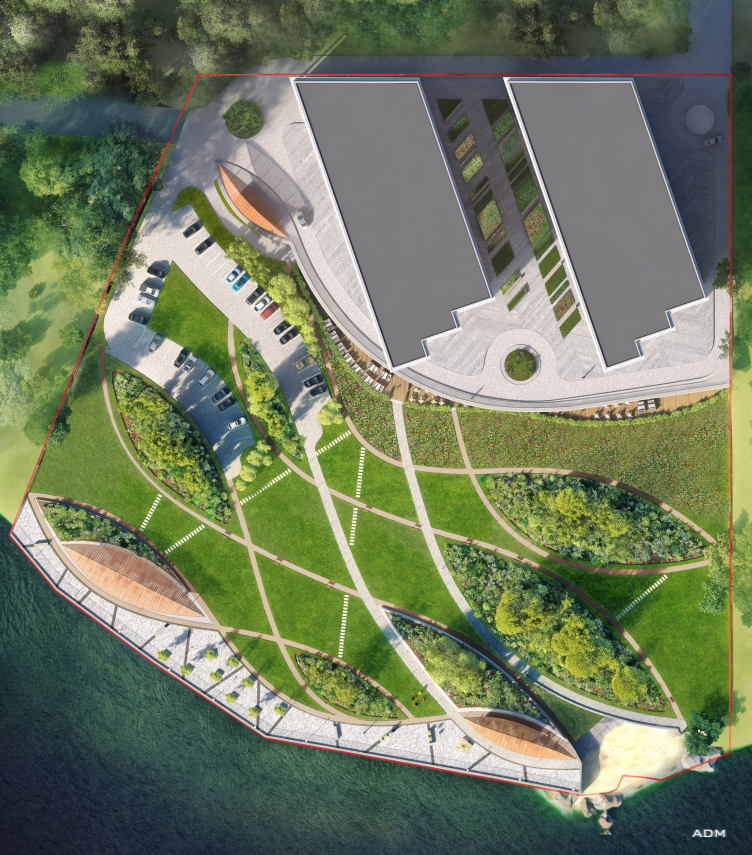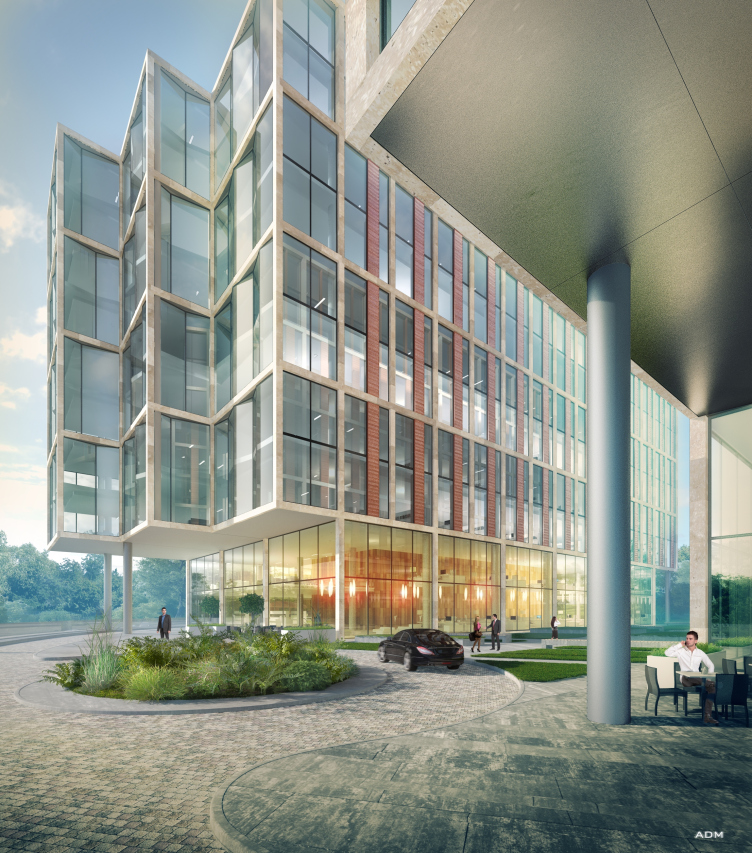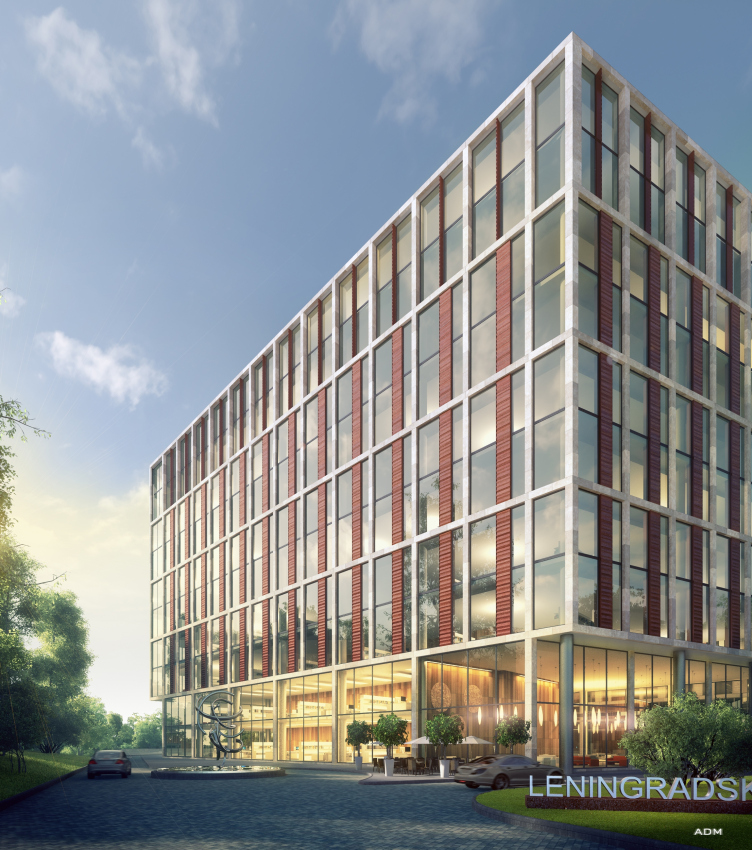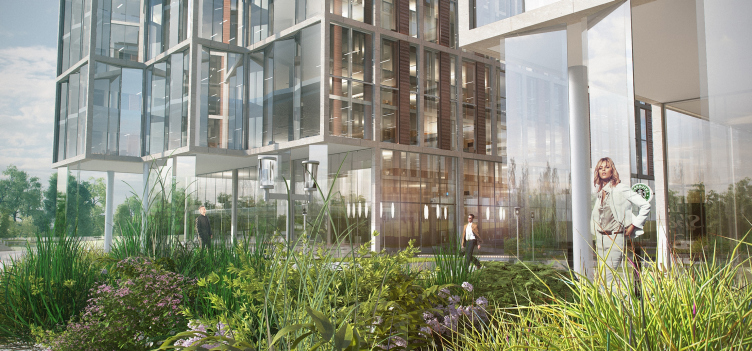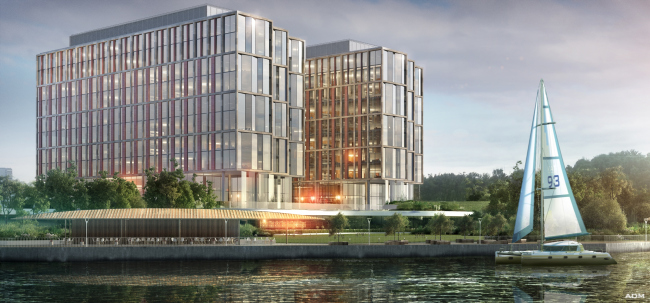
Multifunctional office and business center on the Leningrad Highway. Perspecive view. © ADM
The land site is located not far from the point where the Leningrad Highway crosses Moscow Ring Road, on the bank of the Butakovsky bay. On the plan, it has a trapeze shape but, when viewed from the water, its boundary traces the smooth curve of the shoreline. Still, with all the picturesqueness of its natural landscape, the aggressive urban context and the two large truck roads give this place a rather uneasy character. The list of its immediate neighbors includes the bulky volume of "Metro Cash & Carry" chain supermarket and the recently-built commuter parking lot adjacent to the eastern border of the land site. Behind the designed complex, there is a power transmission line which explains the absence of any nearby buildings whatsoever: only at a far distance the silhouettes of the commuter belt apartment houses are viewable.

Multifunctional office and business center on the Leningrad Highway. Master plan. Visualization. © ADM
Before the decision of building a business center on this territory was made, it was used as a base for storing rubble. For this same reason, the site does not have on it not only any substantial architectural structures but also any trees or shrubs, the lack of which is particularly acute. The idea to repair this omission was suggested to the architects by the presence of a broad water conservation zone that forbids any construction: the building of the office complex occupied but a third of the land site, the part that is the remotest from the water, while the shore area is allotted for the creation of a large and diverse park.
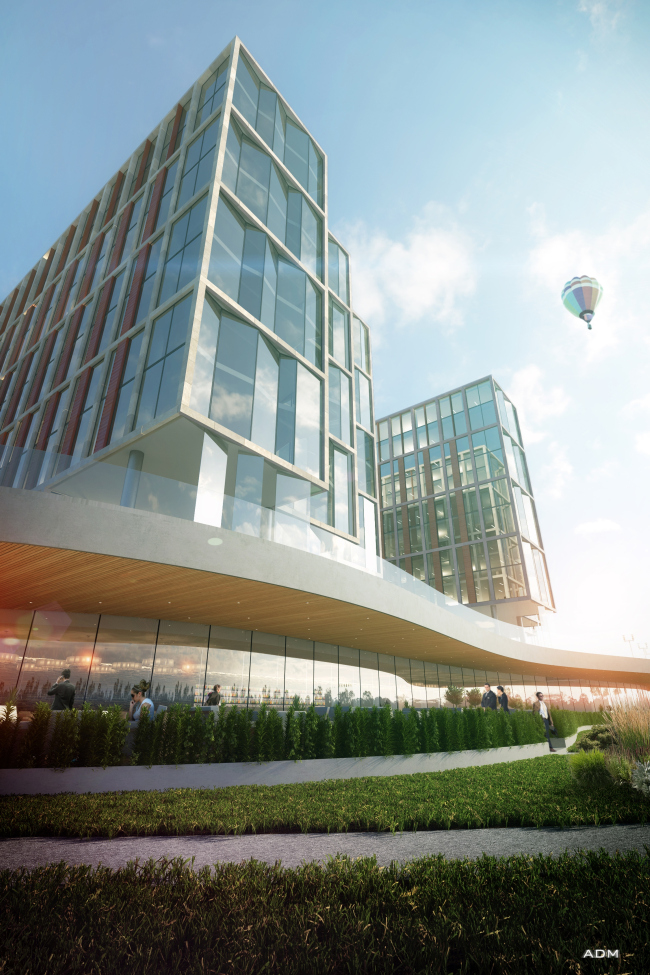
Multifunctional office and business center on the Leningrad Highway. Perspecive view. © ADM
The complex is made up of two equal-sized 11-story towers united by a common stylobate part. On the plan, both towers have a four-square layout and are inscribed into their site at an angle to its boundaries. The side walls of the buildings that perform the role of the main - riverside - facade of the complex, are intentionally designed in a sophisticated manner; they face the water with large ledges. These ledges are completely made of glass, while the proposed "step-like" shape helped not only to diversify the plastics of the complex but also provided the best views of the bay and the park. As Andrew Romanov shares, this part of the building houses all the management offices, while the glazing is executed in the "accordion" shape with widely stretched transparent "bellows" that reflect the clouds sailing over the sky.

Multifunctional office and business center on the Leningrad Highway. Perspecive view. © ADM

Multifunctional office and business center on the Leningrad Highway. Perspecive view. © ADM
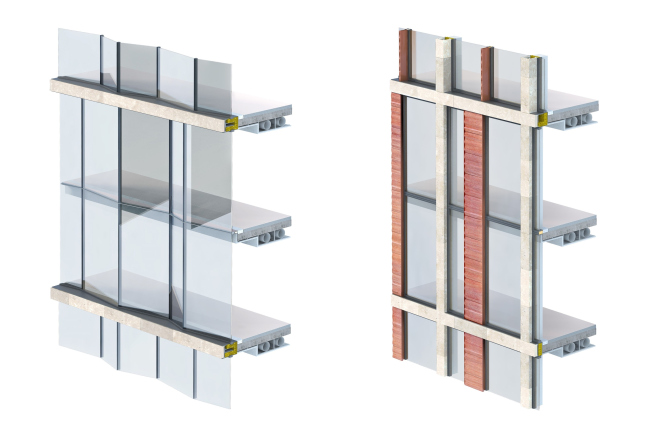
Multifunctional office and business center on the Leningrad Highway. Fragments of the facade. © ADM
The side facades are designed in a more monumental way at the expense of natural stone and terra-cotta panel finish - they form, on the glass canvas of the walls, a rigid geometrical grid of vertical and horizontal lines. The top eleventh floor that contains the maintenance premises is covered by a decorative grille of dark-gray aluminum extrusion and is shifted deeper inside in relation to the main volume of the complex - which partially helps to conceal the true height of the buildings. Between the two buildings of the complex, there is a green courtyard, on top of which - meaning, starting from the third floor and higher up - the offices are situated: the workspaces are grouped along the perimeter of the building and around the main nucleus of the stairways, elevator chutes, and utility lines.
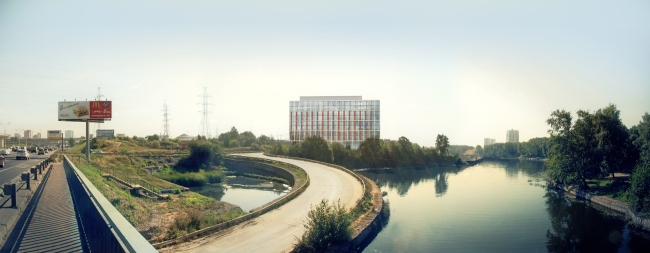
Multifunctional office and business center on the Leningrad Highway. Composite photograph from the side of Moscow Ring Road. © ADM

Multifunctional office and business center on the Leningrad Highway. Perspecive view. © ADM
The first two floors of the complex perform the public functions - they house the recreation areas, while in the summertime there will also be small open-air cafes here. What is interesting is the fact that because of the relief drop of the site the stylobate is only viewable from the bayside. To the park that is going to be there on the bank of the bay, the stylobate is turned with its glass facade with a terrace covered with a smooth-shaped marquee awning that is the favorite element with ADM. It is this "visible" part of the base of the complex that will be occupied by the public zones, while the underground part of the stylobate, just as the two other underground floors of the complex are meant for the parking garage.
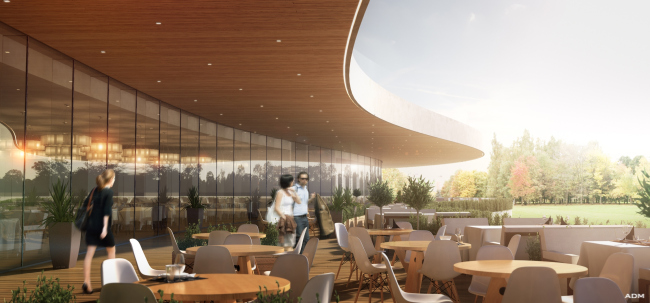
Multifunctional office and business center on the Leningrad Highway. Perspecive view. © ADM
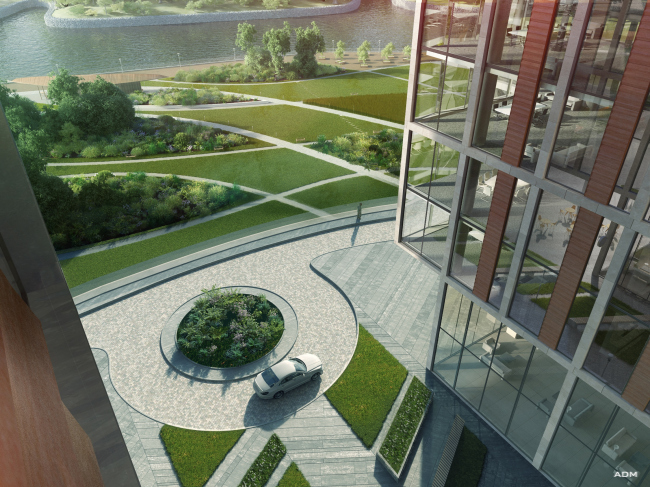
Multifunctional office and business center on the Leningrad Highway. Perspecive view. © ADM
The solution when the terminally graceful and plastic base of the building bleeds into a laconic and rational shape of the main volume is to be found in many ADM projects (suffice it to mention the hotel Hilton Garden Inn in Makhachkala or a business center in the Moscow Region). According to the authors, a person usually perceives a building either from a close range (and in this case it is very important to carefully design of the bottom floors embellishing them with thought-through details) or from a fair distance (and then it is the silhouette that matters). The complex on the Leningrad Avenue became no exception. The stylobate zone that traces the peninsular outline of the site, just like the lower floors of the towers, form a comfortable space that is great to be in and to look at. When viewed from a distance, the silhouette of the complex looks just as imposing and elegant: two large towers that shoot off near the water from a green slope look like a glass portal or an entrance gate to some medieval city.
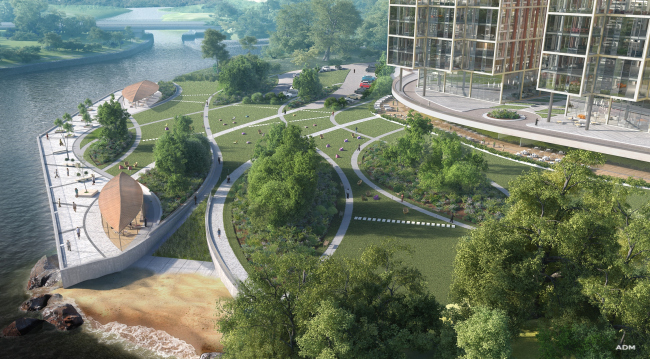
Multifunctional office and business center on the Leningrad Highway. Perspecive view. © ADM
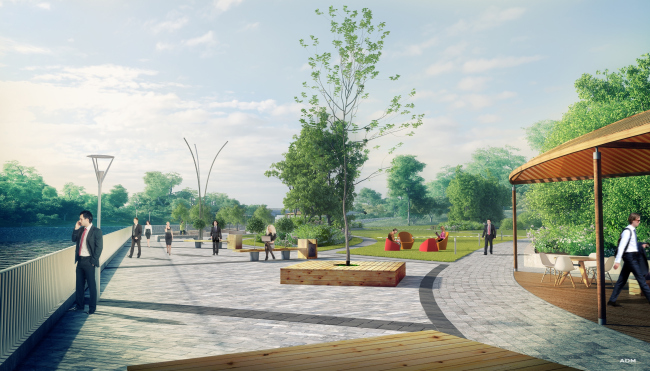
Multifunctional office and business center on the Leningrad Highway. Perspecive view. © ADM
Yet another characteristic feature of ADM projects is the careful design of the adjoining territories. In this case, the linear park that occupies the entire area from the foot of the building down to the embankment attracts as much attention as does the architecture of the complex. Along the shoreline, there runs a wide deck-sheathed embankment. To build it, the architects propose to use the already-existing breast wall. The corners of the peninsular washed by the water of the bay are fixed by two pavilions that are going to be used as cafes. The roofs of these buildings bear an evident resemblance to the leaves of a birch tree - when viewed from above, they will look as if they had been brought here by a gust of autumn wind. The same "leaves", only larger in size, result from the park being dissected by the criss-crossing wave-like trails that pick up and continue the meander pattern of the shoreline. Inside of the "petals" formed in such a way, at some places the man-made green hills spring out. These man-made hills help the architects to crate a multilayer composition of living plants that gradually grow smaller from the center towards the edges. In the middle, tall trees will be planted, surrounded by a belt of shrubs of various height, while the edges will be decorated with bright flowers. As Andrew Romanov shared, such a technique was borrowed from Beth Chateau Gardens located not far from London.

Multifunctional office and business center on the Leningrad Highway. Perspecive view. © ADM
The wave-like trails cross with straight traversing walks that lead from the embankment to the complex. The architects execute them very much like zebra crossings - only the white stripes in them are intercepted with the right green of the grass lawns. One of such walks will connect the office center with a small beach on the bank of the bay that the architects are planning to clean up and improve with white sand and black rocks turning it into one of the most picturesque places of the park. One will hardly be able to use thus beach for actual swimming, though - but it will sure help one to unwind for a moment and forget the bustle of the office and the megalopolis.
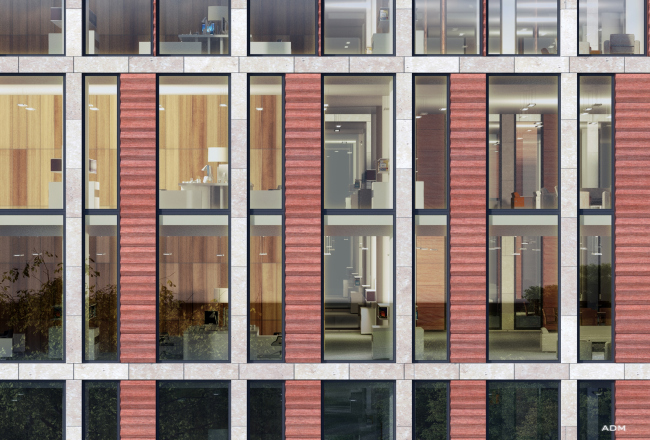
Multifunctional office and business center on the Leningrad Highway. Fragment of the facade. © ADM
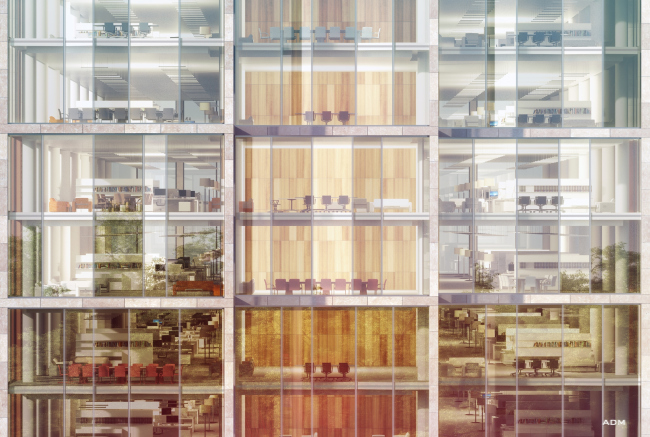
Multifunctional office and business center on the Leningrad Highway. Fragment of the facade. © ADM




